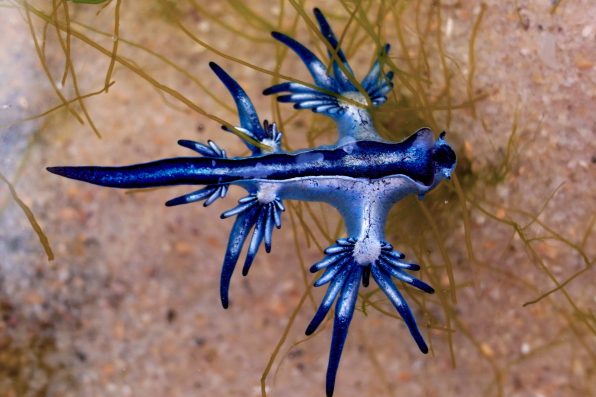Beware Of Blue Dragon Sea Slugs Washing Up On The Shores Of Texas Because While These Tiny Creatures May Look Harmless, They Can Cause A Serious Sting

During this time of year, a bright blue and silver sea slug called the blue dragon is known to wash up on the shores of Texas beaches.
So, if you’re visiting the area while on spring break, you should be mindful of where you step! The tiny creatures look fascinating and harmless, but experts warn against touching them, as it can result in a painful sting.
Blue dragons, also known scientifically as Glaucus atlanticus, grow to about an inch long. They live in the Atlantic, Pacific, and Indian Oceans. Their habitat range is expanding, and climate change may play a role, although no connection has been confirmed.
The sea slugs sail on the surface of the ocean, floating upside down as they travel to wherever the wind and the currents take them.
“Here in Texas, spring is known for being the windy period,” Jace Tunnell, the reserve director at the University of Texas’s Marine Science Institute, said. “So, in March and April, when the conditions get just right and you have big waves and strong southeastern winds, that’s how they get pushed up on our shores.”
They also feed on venomous prey, such as the Portuguese man-of-war. By ingesting their prey’s toxins, they become poisonous themselves. Blue dragons use mucus to neutralize the man-of-war’s stinging cells.
They then steal the cells and store them within their own tissue. When the slugs are blown ashore, they have the potential to release the toxins upon contact with unsuspecting beachgoers.
Fortunately, the small sea dragons don’t make it to shore very often. Their soft bodies usually get torn apart by the time they reach the shore. They also dry up relatively quickly in the sun and the sand.
If you come across a blue dragon along the waterline, make sure to steer clear of it. Their sting causes intense pain that can last up to three hours, producing various symptoms that include nausea, vomiting, disorientation, redness, skin lesions, and blisters filled with fluid.

Sahara Frost – stock.adobe.com – illustrative purposes only, not the actual sea slug
“In very rare cases, there have been people who have died from them,” Tunnell said. Tunnell added that every individual responds differently to a sting. Some aren’t able to handle a sting well and have bad allergic reactions.
If you’re stung, pour vinegar or warm water on the site. Do not rub it with sand or let it touch the ocean water. And, of course, go to the hospital to get the wound treated.
Sign up for Chip Chick’s newsletter and get stories like this delivered to your inbox.
More About:Animals





